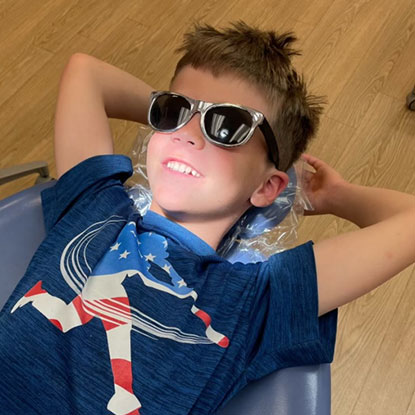As a pediatric dental practice, our goal is to prevent dental problems with a consistent approach to preventive care – at home and with regular professional cleanings and exams. When dental treatment needs to occur our goal is to correct the problem quickly and get each patient back on track to dental health. Depending on the age of a child, we have different treatment options and methods to make the process as comfortable as possible for the child.
Common dental treatment needs
Fillings
When there is dental decay, we remove the affected portion of the tooth and fill it with a white, natural-looking composite filling material.
Extractions
There are several reasons why a tooth may need to be extracted. Traumatic tooth injury, stubborn baby teeth that will not come out on their own, or teeth with so much decay they can’t be restored with a traditional filling, may all need to be extracted. Infection, orthodontic treatment, or problems with a wisdom tooth can also require the removal of a tooth. Depending on the number of teeth needing removal and the position within the jaw, extractions may be completed in our office or may be referred to an oral surgeon.
Space Maintenance After Tooth Extraction
When a primary tooth has been extracted, we often recommend a space maintenance appliance to preserve the space for when the adult tooth erupts. This relatively simple appliance prevents adjacent teeth from moving into the newly open space, minimizing orthodontic challenges in the future.
Stainless Steel Crowns
In the event that a primary/baby tooth has significant dental decay, it may be necessary to put a crown, or cap, on the tooth to stabilize and strengthen the tooth until it comes out naturally. Stainless steel crowns are the most durable and cost-effective solution for these restorations in primary teeth.
Dental Sealants
Sealants are a protective coating painted on a child’s molars. The molars, with their deep crevasses, are the most prone to decay, and dental sealants provide a level of protection from cavities in those vulnerable teeth.
Procedural Sedation Options
We use traditional numbing methods for most dental procedures. Depending on the age, anxiety, and special needs of each patient, we also offer procedural sedation options that are comfortable, safe, and effective.
Minimum Sedation — Nitrous oxide inhalation (laughing gas) is a form of minimum sedation that results in relaxation during treatment. It is the most common form of minimum sedation used in our office and is tolerated well by most patients. The effects wear off quickly so children can return to school or activities
General Anesthesia — Patients who are unable to sit still for longer procedures, or who require more extensive treatment may need general anesthesia. In our practice, general anesthesia is delivered in a hospital setting by Dr. Wendy Daulat, and a hospital anesthesiologist, who administers the anesthesia and monitors the patient throughout.
Sports Dentistry
Sports dentistry is the prevention and treatment of dental trauma. Injuries to the teeth and mouth are common among athletes. It’s important to protect your child’s smile if they play sports. The best thing you can do to protect your child’s smile during any kind of contact sport is to have them wear an appropriate mouthguard. Ask us about it at your next visit!
Emergency Dentistry
Dental emergencies can happen at any time; at home, at school, or during sports. For any dental emergency, where there was impact, bleeding, or tooth loss, you should contact our office for instructions on emergency care. The following list covers many common dental emergencies:
Tooth knocked out
- Find the tooth and gently pick it up by the crown (not the root) and wash it off.
- Don’t touch the roots if possible.
- Call our office as soon as possible!
- Do not try to re-implant the tooth yourself unless instructed to do so.
- The best liquid to transport a tooth in is cold milk or saliva.
- Do not let the tooth dry out and do not wrap it in anything.
Tooth chipped/cracked
- Call our office to see if an emergency appointment is needed.
- If you can find the chipped tooth fragment, place it in milk or saliva and bring it with you to your dental appointment.
Tooth displaced
If a tooth is moved due to trauma, call our office as soon as possible.
Preventing Injury
One of the best ways to prevent injury to your child’s teeth and mouth is to have them wear a mouthguard while playing sports. Many organized sports require them, but consider using them for non-team sports too! There are several types of mouthguards to choose from, and we can help you choose the best one for your child’s particular needs.


